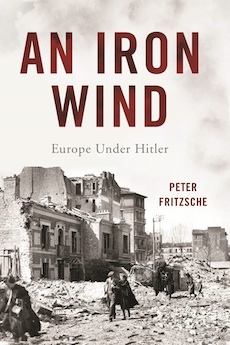Shortlisted for the 2017 Ralph Waldo Emerson Award
By Benjamin Franklin Martin
An Iron Wind—the metaphor is from the Stalingrad World War II memorial—describes the terror imposed by the Nazis as they attempted “to swing the arc of history so that the thousand-year Reich eclipsed the liberal epoch. . . begun with the French Revolution in 1789.” No sense of moral obligation to universal humanity was to survive as the conception of a human species was abandoned in favor of categorizing and qualifying by race.
Basing his account on diaries and contemporary literary works, Fritzsche concentrates on France, where German conquerors attenuated their brutality, and on Poland, where they gave it free range. A single statistic reveals the stark difference in their experience: in France, 2 percent of the population died; in Poland, the figure was 20 percent, ten times higher. Fritzsche adds a consideration of Switzerland, which maintained anxious neutrality throughout the war, best described by the whispered joke, “Six days a week, the Swiss work for Hitler, on the seventh they pray for the victory of the Allies.”
The French were attentistes, “waiting” to see who would win the war, convinced by the conduct of “good Germans” that they could strike a deal with the Nazis. Despite the food rationing and the labor impressments, their hostility was tempered by fear that protest might make things worse. Jean-Paul Sartre, who had a minor role in the resistance, wrote, “the idea of who is one’s enemy is only clear and definite when that enemy is on the other side of the fighting line.” Although many, even most, of the French were aware of what was happening to the Jews, they “usually subordinated this terrible knowledge to their own sufferings.”
For the Poles, rationing and impressment were the least of their agony. Because the Nazis regarded everyone within the country’s boundaries as Untermenschen, “subhuman,” they began an “ambitious racial reordering.” They killed indiscriminately more than 50,000 civilians as they approached Warsaw in September 1939, and then sought with chilling precision to eradicate every member of the Polish elite, business leaders, lawyers, physicians, and academics. They prefigured the Final Solution with the so-called Great Action during the summer of 1942, deporting 300,000 Jews from the Warsaw ghetto to be slaughtered at Treblinka, the toll surpassing the deaths at Hiroshima and Nagasaki combined. A Polish resistance fought fiercely and futilely even as it revealed the power of this this racial reordering, refusing any Jewish involvement as it defined “Polish” by the categories of ethnicity and religion instead of by nationality.
Because Switzerland’s rail lines were subject to German interruption in every direction, its President, Maurice Pilet-Golaz, called on his country to make the “difficult adjustment” to “new conditions.” Yet most of the Swiss saw their polyglot nation as a “counterworld to totalitarianism” and by the end of 1940 suspected that Germany could not win the war. The open acknowledgment by the Nazis of their merciless brutality in eastern Europe revolted them.
The Germans did indeed carefully record, by document and photograph “for the benefit of the master race,” their infliction of misery, their torture, their glee at humiliating and dehumanizing, their effort to strip from their victims every shred of dignity and respect. In presenting this record, Fritzsche makes An Iron Wind not just history but a warning.
Benjamin Franklin Martin (ΦΒΚ, Davidson College, 1969) is Price Professor of History Emeritus, Louisiana State University.




